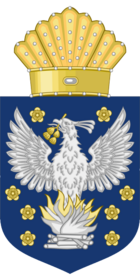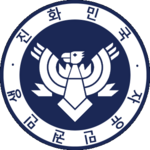Emperor Seongjo of Zhenia
This article is incomplete because it is pending further input from participants, or it is a work-in-progress by one author. Please comment on this article's talk page to share your input, comments and questions. Note: To contribute to this article, you may need to seek help from the author(s) of this page. |
| Li Zichuan | |||||||||||||
|---|---|---|---|---|---|---|---|---|---|---|---|---|---|
| King of Kings, Khagan of the Yemeg and Balakhaat People | |||||||||||||
 Portrait in 1877. | |||||||||||||
| Emperor of Zhenia, Khagan of the Yemeg and Balakhaat people | April 15, 1844 - October 27, 1867 (as Emperor of Shindan) August 1, 1847 - November 26, 1889 (as Khagan of the Yemeg and Balakhaat People) October 27, 1867 - November 26, 1889 (as Emperor of Zhenia) | ||||||||||||
| Coronation | April 15, 1844 | ||||||||||||
| Predecessor | Emperor Jeongjo | ||||||||||||
| Successor | Emperor Saejo | ||||||||||||
| Born | Li Zichuan (李自淸; 이자청) June 4, 1827 Jeonju, Honam Province, Shindan | ||||||||||||
| Died | 26 November 1889 (aged 62) Donggyeong, Empire of Zhenia | ||||||||||||
| Burial | |||||||||||||
| Empress | Empress Soyang | ||||||||||||
| Issue |
| ||||||||||||
| |||||||||||||
| House | Imperial House of Li | ||||||||||||
| Father | Emperor Jeongjo (정조황제) | ||||||||||||
| Mother | Empress Goryun (고륜황후) | ||||||||||||
| Religion | Zhenian Wuism | ||||||||||||
Part of a series on the |
|---|
| History of Zhenia |
 |
| Timeline |
Emperor Seongjo of Zhenia (Classic Zhenian: 陳 聖祖, Modern Zhenian: 대동진제국 성조황제), formerly Emperor Seongjo of Shindan, personal name Li Zichuan (Classic Zhenian: 李自淸, Modern Zhenian: 이자청), was the founder and emperor of the Empire of Zhenia, as well as the last emperor of Shindan, reigning from 1844 to his death in 1905. His rule saw the unification of Zhenia through the Zhenian Civil War, as well as the rapid transformation of Shindan from a feudal hermit state to an industrialized power, as well as the transformation of Zhenia from a decentralized state into an industrialized world power.
Early Life
Emperor Seongjo was born with the name Li Zichuan on June 4, 1827, as an illegitimate second son of King Jeongjo, in the port city of Jeonju, Honam Province. Having spent his early years near the port, Li Zichuan made contact with the Auroran and Southeast Tarsic missionaries and traders, from whom he gained insight into what had been going on outside the Danguk peninsula. At age 7, he became one of the first 20 students to have enrolled in the Jeonju Shinhak Academy, one of the first primary and secondary institutions in the nation to have been established by an Auroran missionary, although the Royal House relocated him to Sanggyeong two years later, fearing that education from Auroran missionaries would become a bad influence to the prince.
With the early death of his brother and the deposition of King Jeongjo's only legitimate son in 1841, Li Zichuan was selected as the crown prince of Shindan, with no other candidates among the direct descendants of the King.
As King of the Shindan dynasty
Directly after his coronation in 1844, Li Zichuan vowed that the Shindan would end its vassal position with the Empire of Greater Wu, following a petition calling for the Shindan to become an empire and stand even against the Greater Wu. Although his declaration was met with explicit dissent from the Wu, Li Zichuan responded firmly, calling for the preparation of war against the Greater Wu. Under his leadership, the Shindan nationalized the assets of regional aristocrats and its rare-earth mines to acquire the funds needed for war, while also calling for the collection of militiamen nationwide. In addition to domestic preparations, with the assistance from envoys of the kingdoms of Husgratin and Zonnenbord, Li Zichuan was able to leverage both diplomatic assistance and the acquisition of Auroran weaponry from the two Auroran kingdoms, in exchange of the opening of three additional trading ports to the Aurorans, freedom of religion inside Shindan and the establishment of embassies of the respective nations in Shindan.
Upon initiation of the war in November 1846, Li Zichuan broke the tradition of the Shindanese royal refuge by temporarily relocating the capital to Sanggyeong, rather than moving to the Haedong Islands, while he led the Royal Guards in the war himself. Following a series of decisive victories against the Greater Wu, the Shindan had forced the retreat of the Greater Wu forces further away from the original border, ultimately flanking Seoggyeong by July 1847. The Second Shindan- Wu War, under his leadership, ended with the Treaty of Sanggyeong, shifting the borders of the Shindan further west and bringing the Shindan under a personal union with the Yemeg-Balakhaat Empire.
During the Zhenian Civil War
Under the Empire of Zhenia
Shinzhen Doctrine
Main Article: Shinzhen Doctrine, Shinzhen Movement
